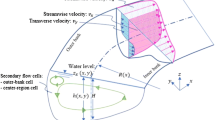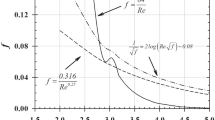Abstract
In this paper, a new continuum traffic model is developed considering the backward-looking effect through a new positive backward equilibrium speed function. As compared with the conventional full velocity difference model, the backward equilibrium velocity function, which is largely acceptably grounded from mathematical and physical perspectives, plays an important role in significantly enhancing the stability of the traffic flow field. A linear stability condition is derived to demonstrate the flow neutralization capacity of the model, whereas the Korteweg–de Vries–Burgers equation and the attendant analytical solution are deduced using nonlinear analysis to observe the traffic flow behavior near the neutral stability condition. A numerical simulation, used to determine the flow stability enhancement efficiency of the model, is also conducted to verify the theoretical results.






Similar content being viewed by others
References
Ma, G., Ma, M., Liang, S., Wang, Y., Zhang, Y.: An improved car-following model accounting for the time-delayed velocity difference and backward looking effect. Commun. Nonlinear Sci. Numer. Simul. 85, 105221 (2020). https://doi.org/10.1016/J.CNSNS.2020.105221
Tanimoto, J., Nakamura, K.: Social dilemma structure hidden behind traffic flow with route selection. Phys. A Stat. Mech. its Appl. 459, 92–99 (2016). https://doi.org/10.1016/J.PHYSA.2016.04.023
Tanimoto, J.: Traffic Flow Analysis Dovetailed with Evolutionary Game Theory. In: Springer 6. pp. 159–182 (2015)
Ge, H., Meng, X., Ma, J., Lo, S., Ge, H., Meng, X., Ma, J., Lo, S.: An improved car-following model considering influence of other factors on traffic jam. PhLA. 377, 9–12 (2012). https://doi.org/10.1016/J.PHYSLETA.2012.10.005
Ou, H., Tang, T.Q., Zhang, J., Zhou, J.M.: A car-following model accounting for probability distribution. Phys. A Stat. Mech. Appl. 505, 105–113 (2018). https://doi.org/10.1016/j.physa.2018.03.072
Orosz, G., Krauskopf, B., Wilson, R.E.: Bifurcations and multiple traffic jams in a car-following model with reaction-time delay. Phys. D Nonlinear Phenom. 211, 277–293 (2005). https://doi.org/10.1016/j.physd.2005.09.004
Guo, L., Zhao, X., Yu, S., Li, X., Shi, Z.: An improved car-following model with multiple preceding cars’ velocity fluctuation feedback. Phys. A Stat. Mech. Appl. 471, 436–444 (2017). https://doi.org/10.1016/j.physa.2016.12.071
An, S., Xu, L., Qian, L., Chen, G., Luo, H., Li, F.: Car-following model for autonomous vehicles and mixed traffic flow analysis based on discrete following interval. Phys. A Stat. Mech. its Appl. 560, 125246 (2020). https://doi.org/10.1016/j.physa.2020.125246
Jiang, R., Wang, R., Wu, Q.S.: Two-lane totally asymmetric exclusion processes with particle creation and annihilation. Phys. A Stat. Mech. its Appl. 375, 247–256 (2007). https://doi.org/10.1016/j.physa.2006.08.025
Peng, G., Lu, W., He, H., Gu, Z.: Nonlinear analysis of a new car-following model accounting for the optimal velocity changes with memory. Commun. Nonlinear Sci. Numer. Simul. 40, 197–205 (2016). https://doi.org/10.1016/j.cnsns.2016.04.024
Jiang, R., Wu, Q.S., Zhu, Z.J.: A new continuum model for traffic flow and numerical tests. Transp. Res. Part B Methodol. 36, 405–419 (2002). https://doi.org/10.1016/S0191-2615(01)00010-8
Piccoli, B., Tosin, A.: Vehicular Traffic: A review of continuum mathematical models. In: Encyclopedia of complexity and systems science. pp. 9727–9749. Springer New York (2009)
Khoshyaran, M.M., Lebacque, J.P.: Continuum traffic flow modelling: network approximation, flow approximation. In: Springer proceedings in physics. pp. 505–513. Springer Science and Business Media Deutschland GmbH (2020)
Nagatani, T.: Thermodynamic theory for the jamming transition in traffic flow. Phys. Rev. E Stat. Phys. Plasmas Fluids Relat. Interdiscip. Top. 58, 4271–4276 (1998). https://doi.org/10.1103/PhysRevE.58.4271
Gupta, A.K., Katiyar, V.K.: A new anisotropic continuum model for traffic flow. Phys. A Stat. Mech. Appl. 368, 551–559 (2006). https://doi.org/10.1016/j.physa.2005.12.036
Ngoduy, D., Hoogendoorn, S.P., Liu, R.: Continuum modeling of cooperative traffic flow dynamics. Phys. A Stat. Mech. Appl. 388, 2705–2716 (2009). https://doi.org/10.1016/j.physa.2009.02.040
Chen, T., Shi, X., Wong, Y.D.: A lane-changing risk profile analysis method based on time-series clustering. Phys. A Stat. Mech. Appl. 565, 125567 (2021). https://doi.org/10.1016/j.physa.2020.125567
Benjamin, S.C., Johnson, N.F., Hui, P.M.: Cellular automata models of traffic flow along a highway containing a junction. J. Phys. A. Math. Gen. 29, 3119–3127 (1996). https://doi.org/10.1088/0305-4470/29/12/018
Tian, J., Jia, B., Ma, S., Zhu, C., Jiang, R., Ding, Y.X.: Cellular automaton model with dynamical 2D speed-gap relation. Transp. Sci. 51, 807–822 (2017). https://doi.org/10.1287/trsc.2015.0667
Zhu, W.X., Zhang, H.M.: Analysis of mixed traffic flow with human-driving and autonomous cars based on car-following model. Phys. A Stat. Mech. Appl. 496, 274–285 (2018). https://doi.org/10.1016/j.physa.2017.12.103
Kala, R., Warwick, K.: Motion planning of autonomous vehicles in a non-autonomous vehicle environment without speed lanes. Eng. Appl. Artif. Intell. 26, 1588–1601 (2013). https://doi.org/10.1016/j.engappai.2013.02.001
Li, Z., Li, W., Xu, S., Qian, Y., Sun, J.: Traffic behavior of mixed traffic flow with two kinds of different self-stabilizing control vehicles. Phys. A Stat. Mech. Appl. 436, 729–738 (2015). https://doi.org/10.1016/j.physa.2015.05.090
Peng, G.: A new lattice model of traffic flow with the consideration of individual difference of anticipation driving behavior. Commun. Nonlinear Sci. Numer. Simul. 18, 2801–2806 (2013). https://doi.org/10.1016/j.cnsns.2013.03.007
Li, X., Li, Z., Han, X., Dai, S.: Effect of the optimal velocity function on traffic phase transitions in lattice hydrodynamic models. Commun. Nonlinear Sci. Numer. Simul. 14, 2171–2177 (2009). https://doi.org/10.1016/j.cnsns.2008.06.017
Li, Z., Zhang, R., Xu, S., Qian, Y.: Study on the effects of driver’s lane-changing aggressiveness on traffic stability from an extended two-lane lattice model. Commun. Nonlinear Sci. Numer. Simul. 24, 52–63 (2015). https://doi.org/10.1016/j.cnsns.2014.12.007
Zhang, G., Sun, D.H., Zhao, M.: Phase transition of a new lattice hydrodynamic model with consideration of on-ramp and off-ramp. Commun. Nonlinear Sci. Numer. Simul. 54, 347–355 (2018). https://doi.org/10.1016/j.cnsns.2017.06.011
Zhu, C., Zhong, S., Ma, S.: Two-lane lattice hydrodynamic model considering the empirical lane-changing rate. Commun. Nonlinear Sci. Numer. Simul. 73, 229–243 (2019). https://doi.org/10.1016/j.cnsns.2019.02.010
Gupta, A.K., Redhu, P.: Analysis of a modified two-lane lattice model by considering the density difference effect. Commun. Nonlinear Sci. Numer. Simul. 19, 1600–1610 (2014). https://doi.org/10.1016/j.cnsns.2013.09.027
Lighthill M.J., W.G.B.: On kinematic waves II. A theory of traffic flow on long crowded roads. Proc. R. Soc. London. Ser. A. Math. Phys. Sci. 229, 317–345 (1955). https://doi.org/10.1098/rspa.1955.0089
Lighthill M.J., W.G.B.: On kinematic waves I. Flood movement in long rivers. Proc. R. Soc. London. Ser. A. Math. Phys. Sci. 229, 281–316 (1955). https://doi.org/10.1098/rspa.1955.0088
Richards, P.I.: Shock waves on the highway. Oper. Res. 4, 42–51 (1956). https://doi.org/10.1287/opre.4.1.42
Payne, H.J.: Mathematical models of public systems. Simul. Counc. 1, 51–61 (1971). https://doi.org/10.1098/rspa.1955.0089
Bando, M., Hasebe, K., Nakayama, A., Shibata, A., Sugiyama, Y.: Dynamical model of traffic congestion and numerical simulation. Phys. Rev. E. 51, 1035–1042 (1995). https://doi.org/10.1103/PhysRevE.51.1035
Helbing, D., Tilch, B.: Generalized force model of traffic dynamics. Phys. Rev. E. Stat. Phys. Plasmas Fluids Relat. Interdiscip. Top. 58, 133–138 (1998). https://doi.org/10.1103/PhysRevE.58.133
Jiang, R., Wu, Q., Zhu, Z.: Full velocity difference model for a car-following theory. Phys. Rev. E. Stat. Phys. Plasmas. Fluids. Relat. Interdiscip. Top. 64, 4 (2001). https://doi.org/10.1103/PhysRevE.64.017101
Nakayama, A., Sugiyama, Y., Hasebe, K.: Effect of looking at the car that follows in an optimal velocity model of traffic flow. Phys. Rev. E. Stat. Phys. Plasmas Fluids Relat. Interdiscip. Top. 65, 016112 (2002). https://doi.org/10.1103/PhysRevE.65.016112
Anowar Hossain, M., Kabir, K.M.A., Tanimoto, J.: Improved car-following model considering modified backward optimal velocity and velocity difference with backward-looking effect. (2021)
Hossain, M.A., Tanimoto, J.: The “backward looking” effect in the continuum model considering a new backward equilibrium velocity function. Nonlinear Dyn. 87, 149–157 (2021). https://doi.org/10.1007/s11071-016-3032-6
Liu, Z., Wang, J., Ge, H., Cheng, R.: KdV-Burgers equation in the modified continuum model considering the “backward looking” effect. Nonlinear Dyn. 91, 2007–2017 (2018). https://doi.org/10.1007/s11071-017-3999-7
Chen, C., Cheng, R., Ge, H.: An extended car-following model considering driver’s sensory memory and the backward looking effect. Phys. A Stat. Mech. Appl. 525, 278–289 (2019). https://doi.org/10.1016/j.physa.2019.03.099
Wang, Q., Ge, H.: An improved lattice hydrodynamic model accounting for the effect of “backward looking” and flow integral. Phys. A Stat. Mech. Appl. 513, 438–446 (2019). https://doi.org/10.1016/j.physa.2018.09.025
Wang, Z., Ge, H., Cheng, R.: Nonlinear analysis for a modified continuum model considering driver’s memory and backward looking effect. Phys. A Stat. Mech. Appl. 508, 18–27 (2018). https://doi.org/10.1016/j.physa.2018.05.072
Jiao, Y., Ge, H., Cheng, R.: Nonlinear analysis for a modified continuum model considering electronic throttle (ET) and backward looking effect. Phys. A Stat. Mech. Appl. 535, 122362 (2019). https://doi.org/10.1016/j.physa.2019.122362
Herrmann, M., Kerner, B.S.: Local cluster effect in different traffic flow models. Phys. A Stat. Mech. Appl. 255, 163–188 (1998). https://doi.org/10.1016/S0378-4371(98)00102-2
Acknowledgements
This study was partially supported by the Grant-in-Aid for Scientific Research (KAKENHI) from JSPS (Grant No. JP 19KK0262, JP 20H02314, JP 20K21062) awarded to Professor Tanimoto.
Author information
Authors and Affiliations
Corresponding author
Additional information
Publisher's Note
Springer Nature remains neutral with regard to jurisdictional claims in published maps and institutional affiliations.
Rights and permissions
About this article
Cite this article
Hossain, M.A., Tanimoto, J. The “backward-looking” effect in the continuum model considering a new backward equilibrium velocity function. Nonlinear Dyn 106, 2061–2072 (2021). https://doi.org/10.1007/s11071-021-06894-2
Received:
Accepted:
Published:
Issue Date:
DOI: https://doi.org/10.1007/s11071-021-06894-2




